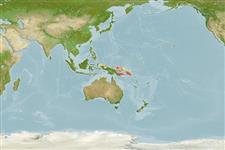>
Ovalentaria/misc (Various families in series Ovalentaria) >
Pomacentridae (Damselfishes) > Pomacentrinae
Etymology: Chrysiptera: Greek, chrysos = golden + Greek, pteron = fin, wing (Ref. 45335); cymatilis: From the Latin for sea-colored or blue, in reference to its characteristic coloration (Ref. 31117).
Environment: milieu / climate zone / depth range / distribution range
Ökologie
seewasser riff-verbunden; tiefenbereich 3 - 20 m (Ref. 31117), usually 3 - 20 m (Ref. 41819). Tropical
Western Central Pacific: Bismarck Archipelago and Milne Bay Province of Papua
New Guinea and Solomon Is.
Size / Gewicht / Alter
Maturity: Lm ? range ? - ? cm
Max length : 3.6 cm SL Männchen/unbestimmt; (Ref. 31117)
Kurzbeschreibung
Bestimmungsschlüssel | Morphologie | Morphometrie
Rückenflossenstacheln (insgesamt) : 13; Rückenflossenweichstrahlen (insgesamt) : 10 - 11; Afterflossenstacheln: 2; Afterflossenweichstrahlen: 10 - 12. Tubed lateral line scales 11-14; brilliant deep blue with lighter blue ocellus-like markings on head and breast, and black spot or blotch at base of posterior dorsal rays; caudal fin emarginate (Ref. 31117). Body depth 1.9-2.2 in SL (Ref. 90102).
Adults are found in sheltered seaward coral reefs and lagoons (Ref. 31117), in aggregations within Acropora sp. and Seriatopora histrix (Ref. 41819). Presumably feeding on zooplankton (Ref. 31117). Oviparous, distinct pairing during breeding (Ref. 205). Eggs are demersal and adhere to the substrate (Ref. 205). Males guard and aerate the eggs (Ref. 205). Diurnal species (Ref. 52881).
Life cycle and mating behavior
Maturities | Fortpflanzung | Spawnings | Egg(s) | Fecundities | Larven
Oviparous, distinct pairing during breeding (Ref. 205). Eggs are demersal and adhere to the substrate (Ref. 205). Males guard and aerate the eggs (Ref. 205).
Hunnam, P., A. Jenkins, N. Kile and P. Shearman, 2001. Bismarck-Solomon Seas Ecoregion: Papua New Guinea Solomon Islands. p. 86. In Mangubhai, S., B. Masianini, D. Gorman and A. Jenkins (eds). Marine Resource Management and Conservation Planning. (Ref. 41819)
IUCN Rote Liste Status (Ref. 130435)
Bedrohung für Menschen
Harmless
Nutzung durch Menschen
Tools
Zusatzinformationen
Download XML
Internet Quellen
Estimates based on models
Preferred temperature (Ref.
123201): 27.3 - 29.1, mean 27.8 °C (based on 10 cells).
Phylogenetic diversity index (Ref.
82804): PD
50 = 0.5000 [Uniqueness, from 0.5 = low to 2.0 = high].
Bayesian length-weight: a=0.01000 (0.00244 - 0.04107), b=3.04 (2.81 - 3.27), in cm total length, based on all LWR estimates for this body shape (Ref.
93245).
Trophic level (Ref.
69278): 3.4 ±0.45 se; based on food items.
Widerstandsfähigkeit (Ref.
120179): hoch, Verdopplung der Population dauert weniger als 15 Monate. (Preliminary K or Fecundity.).
Fishing Vulnerability (Ref.
59153): Low vulnerability (10 of 100).
